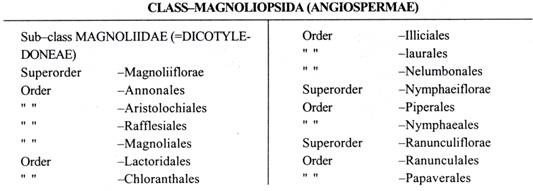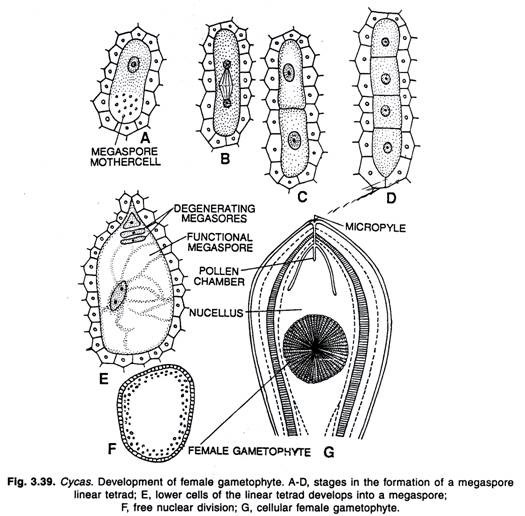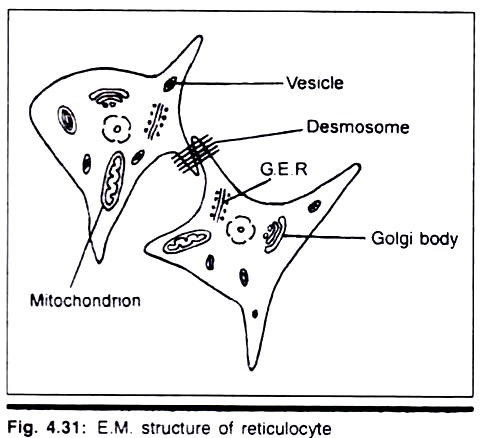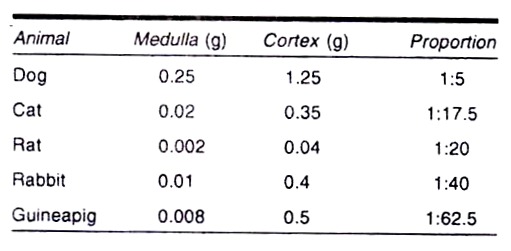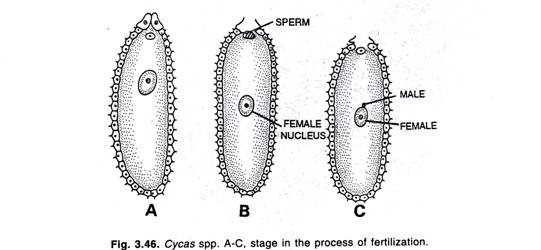Here is an essay on the ‘Families of Dicotyledons’ for class 11 and 12. Find paragraphs, long and short essays on the ‘Families of Dicotyledons’ especially written for school and college students.
Families of Dicotyledons
Essay Contents:
- Essay on Ranunculaceae
- Essay on Magnoliaceae
- Essay on Annonaceae
- Essay on Nymphaeaceae
- Essay on Papaveraceae
- Essay on Cruciferae (Brassicaceae)
Essay # 1. Ranunculaceae (Buttercup, Crowfoot family) :
The family is represented by 50 genera and more than 1,900 species found to occur mainly in the North Temperate Zone. In India, 20 genera and 154 species are found to grow mostly in the hilly regions.
The type genus of the family is Ranunculus.
Systematic Position:
Identifying Characteristics:
1. Plants are generally herbs.
2. Leaves radicle or cauline, alternate, exstipulate, with sheathing leaf base and incised blades.
3. Flowers solitary or in racemose or cymose inflorescence; bisexual, hypogynous and commonly actinomorphic.
4. Stamens usually many, free, spirally arranged, anthers extrorse.
5. Carpels few to many, apocarpous (carpels free), placentation parietal.
6. Fruit aggregate of follicles or achene.
Floral Formula:
Ranunculaaceae: Distinctive Features:
Phylogeny and Systematic:
The family shows affinity with both monocotyledons (Alismataceae, Hydrocharitaceae etc.) and dicotyledons (Magnoliaceae, Berberidaceae etc.).
Many taxonomists consider the family as primitive one of Dicotyledons.
They are considered as primitive family because of the following characteristics:
1. Herbaceous habit,
2. Bisexual and actinomorphic flower,
3. Stamens numerous, free and spirally arranged,
4. Carpels numerous, free and spirally arranged,
5. Ovule anatropous,
6. Fruit follicular.
The advanced characteristics of this family are:
1. Presence of unisexuality,
2. Few and whorl appendages,
3. Zygomorphic flower,
4. Connation in gynoecium, and
5. Fruit-achene.
Bentham and Hooker placed the Natural order Ranunculaceae in the cohort (= order) Ranales of series I Thalamiflorae under subclass Polypetalae and class Dicotyledons.
Engler did not consider the family as primitive over the amentiferous monochlamydous families and placed it in more advanced order after the 17th order Centrospermae under subclass Archichlamydeae of class Dicotyledoneae.
Hutchinson placed the family in the order Ranales under the division II, Herbaceae of subphylum Dicotyledones.
Bentham and Hooker divided the Natural order Ranunculaceae into 5 tribes, Clematideae, Anemoneae, Ranunculeae, Helleboreae and Paeonieae. Engler and Prantl and many others have considered only 3 tribes, Helleboreae, Anemoneae and Paeonieae. The tribe Helleboreae have more than one ovule in a carpel and have follicular fruits, thereby Hutchinson (1959, 69) separated it from Ranunculaceae and raised as a family Helleboraceae.
The genus Paeonia differs from other members of Ranunculaceae because of the following characteristics:
1. Numerous centrifugal stamens,
2. Presence of disc around the carpels and
3. Presence of aril late seeds.
For the above, Worsdell (1908) separated Paeonia and created a separate unigeneric family Paeoniaceae. Later, this was recognised by Corner (1946) and many other recent workers like Hutchinson (1959, 69), Takhtajan (1969, 80) and Cronquist (1968, 81).
Common Plants:
1. Clematis gouriana Roxb.;
2. Naravelia zeylanica DC.;
3. Nigella sativa L.;
4. Ranunculus sceleratus L.;
5. Thalictrum javanica BI.
Key to Genera:
I. Carpel 1-ovuled, fruits achene;
1. Leaves opposite, compound; plants are usually climbing.
i. Sepals 4, petaloid; petals and tendril absent. ………. Clematis.
ii. Sepals as many as petals-4 or 5, third or terminal leaflet modified into tendril. …… Naravelia.
2. Leaves alternate or radicle; plants are usually herbs.
i. Sepals petaloid, petals absent, flowers involucrate. ……… Anemone.
ii. Sepals petaloid, petals absent, flowers non-involucrate……………….Thalictrum.
iii. Sepals 3-5, deciduous, petals 5. …………Ranunculus.
II. Carpels many-ovuled, fruit follicles;
1. Leaves alternate or radicle, plants are usually herbs.
i. Carpels united at the base, flowers regular.
a. Sepals petaloid and as many as petals; 5 petals long, clawed and bifid, leaves bi-pinnate. … Nigella.
ii. Carpels free, flowers irregular.
a. Sepals 5, yellow or white, posterior one helmet-shaped, leaves palmati- partite or seldom entire, plants usually twining. ……….Aconitum.
b. Sepals 5, purplish or pale blue, dorsal members spurred like those of petals, leaves palmately lobed, plants erect. ……….Delphinium.
Plants of Economic Importance:
The family has a number of ornamental plants, medicinal plants. Seeds of some are used as condiments.
These are:
A. Ornamental Plants:
The following are the plants, used in gardening because of their attractive flowers:
1. Aconitun bicolor Schult. and A. napellus L. known as Aconite.
2. Anemone sylvestris L. and A. parviflora Michx. These are known as Wind flower.
3. Aquilegia vulgare L. is known as Columbine.
4. Caltha palustris L. Commonly known as Marsh marigold.
5. Clematis vitaba L. and C. paniculata Thunb. These are commonly known as Virgin-bowers.
6. Delphinium cashmerianum Royle and D. ajacis L. Commonly known as Larkspur.
7. Nigella damascene L. is known as Love- in-a-mist.
8. Paeonia emodi Wall. Commonly called Peony.
9. Ranunculus asiaticus L. and R. repens L. Commonly known as Buttercups.
10. Thalictrum alpinum L. Known as Meadow-rue.
B. Medicinal Plants:
This family is important in respect of drug production.
The important plants are:
1. Aconitun napellus L. The roots of this plant are good source of aconite. It is used to control rheumatism and also as nerve sedative.
2. Actaea spicata. The roots are used as nerve sedative.
3. Adonis aestivalis L. The roots are used as cardiac stimulant.
4. Anemone Pulsatilla L. Plants yield the well known homoeopathic medicine Pulsatilla, used during nervous exhaustion.
5. Delphinium elatum L., D. brunonianum Royle and D. vestitum Wall. The plants are used for the respiratory and cardiac depressants.
6. Helleborus niger L. The plant is used to control worms and skin infections.
7. Hydrastis canadensis L. (Orange root). Roots of the plant are used as an antidote for snake bite.
8. Nigella sativa L. (Kala jeera, Black fennel). The plants are used in the treatment of bronchial asthma and cough.
9. Ranunculus muricatus L. and R. arvensis L. The juice of the plants is used to control intermittent fever.
C. Condiments:
1. Nigella sativa L. (Kala jeera, Black fennel). The seeds are used as condiments in cooking.
Essay # 2. Magnoliaceae (Magnolia Family):
The family Magnoliaceae is represented by 7 genera and 230 species found to grow in tropical region of both Asia and America and also extends to North Temperate Zone. The family is represented in India by 8 genera and about 27 species found to grow mainly in the north temperate regions of Himalayas.
The type genus of the family is Magnolia:
Systematic Position:
Identifying Characteristics:
1. Plants are shrubs or woody trees.
2. Flowers commonly bisexual, trimerous, hypogynous, actinomorphic.
3. Floral members are arranged on elongated or convex thalamus.
4. Perianth members are petaloid and arranged in whorls.
5. Carpels many, apocarpous and spirally arranged.
6. Fruits aggregate of follicle, samara or berry.
Floral Formula:
Phylogeny and Systematic:
The family Magnoliaceae is related to Annonaceae and other members of the order Ranales.
Magnoliaceae: Distinctive Features:
Recent phylogenetists like Hutchinson (1969, 73), Takhtajan (1969, 80), Cronquist (1968, 81) considered the family Magnoliaceae as the most primitive among the angiosperms for the following characteristics:
1. Plants are woody with little differentiated calyx and corolla,
2. Stamens numerous, carpel numerous and both are arranged spirally on an elongated and conical axis.
Bentham and Hooker, Engler and Prantl and others included the family under Ranales. Later, Hutchinson and Cronquist segregate Magnoliaceae and other families from Ranales and placed them under the order Magnoliales.
Based on cytological studies, Whittaker (1933) suggested the creation of the families Winteraceae, Trochodendraceae, llliciaceae, Schizandraceae and Eupteleaceae from the Magnoliaceae. Hutchinson (1959, 69) recognized the above families except Eupteleaceae, which he merged with Schizandraceae.
Cronquiest (1968) and Takhtajan (1969) included Winteraceae and Magnoliaceae under Magnoliales and llliciaceae and Schizandraceae in a new order Illiciales derived from the Magnoliales.
Common Plants:
1. Magnolia grandiflora L.;
2. M. montana Bl.;
3. Michelia champaca L.
4. M. doltsopa Buch. – Ham.
5. M. cathcartii Hk. f. & T.
Key to Genera: 0
I. Erect trees or shrubs, conspicuous;
1. Gynophore absent –
i. Carpels closely aggregated, flowers dehiscing dorsally, ovules 2 or few, flowers terminal. …….. Magnolia.
2. Gynophore present –
i. Carpels in loose spike, gynophore stalked, persistent, flowers axillary and solitary. …………….. Michelia.
Plants of Economic Importance:
The plants of this family are not so economically important. Some are used as ornamental plants, timbers, condiments, volatile oils etc.
A. Ornamental Plants:
Magnolia denudata Desv., M. grandiflora L., M. pterocarpa Roxb.; Michelia champaca L., M. fuscata Blume and Liriodendron tulipifera L. (Tulip tree). The plants are cultivated as ornamental plants for their beautiful fragrant flowers and also for the glossy leaves.
B. Timber Yielding Plants:
Liriodendron tulipifera L. (Tulip tree), Michelia doltsopa Buch.-Ham. (Syn. M. excelsa DC. ex Wall) and different species of Magnolia and Talauma are very much useful for their timber. These timbers are used for tea boxes, furniture, planking, etc.
C. Condiments:
The fruits of Illicium verum Hook. f. and l. griffithii Hook. f. are used as condiment for flavouring confectionary, curries, etc.
D. Volatile Oil:
1. The flowers of Magnolia grandiflora L. and Michelia champaca L. are the source of a volatile oil used in cosmetics and perfumery.
2. The fruits of Illicium verum Hook. f. and l. griffithii Hook. f. yield an essential oil which relieves colic pain and cough. It is also used in stomachic and carminative.
E. Other uses:
1. Michelia champaca L. The flowers yield a yellow dye used in textiles.
2. Michelia champaca L., Kadsura roxburghiana Arn. and Schizandra grandiflora Hook. f. & Thorns. The fruits are edible.
Essay # 3. Annonaceae (Custard Apple Family):
The family Annonaceae is represented by about 128 genera and 2,300 species growing widely in the tropical region of the world. In India, the family is represented by 26 genera and about 200 species found mostly in the peninsular region of India.
The type genus of the family is Annona.
Systematic Position:
Identifying Characteristics:
1. Plants are shrubs or woody trees.
2. Leaves simple, exstipulate, alternate and gland dotted.
3. Flowers are small, bisexual, trimerous and spirocyclic.
4. Perianth in three whorls, outer sepaloid and inner two petaloid.
5. Stamens numerous, spirally arranged; anthers long with tunicate connective, extrorse.
6. Carpels numerous or few on slightly elongate convex thalamus.
7. Fruits etaerio of drups or berries.
Floral Formula:
Annonaceae: Distinctive Features:
Phylogeny and Systematic:
The family Annonaceae is nearly related and advanced than Magnoliaceae. The Annonaceae and Magnoliaceae are very close and possibly derived from the same ancestral stock.
Bentham and Hooker, Engler and Prantl and others included the family under Ranales. But, Hutchinson (1959, 69) placed the family Annonaceae under the order Annonales. Later, Takhtajan (1969, 80) and Cronquist (1968, 81) included Annonaceae under the order Magnoliales.
Common Plants:
1. Annona reticulata L.;
2. A. squamosa L.;
3. Cananga odorata Hook. f. & Thorns.);
4. Polyalthia cerasoides Benth. & Hook.;
5. P. longifolia L. etc.
Key to Genera:
I. Carpels Numerous, Distinct, Indehiscent:
1. Petals imbricate in bud –
i. Corolla-members biseriate, sepals valvate, connective truncate, torous flat. …….. Uvaria.
2. Petals valvate in bud –
i. Corolla-members conniving at the concave base covering the stamens with tunicated or produced anther cells, peduncles hooked ……………… Artabotrys.
ii. Corolla-members spreading from the base, flat, lanceolate, anther cells lanceolate –
Ovules numerous in 2 series on the ventral suture…….. Cananga.
Ovules 1 -2, basal or subbasal, stamens cuneate, fruit 1 -seeded ……….. Polyalthia.
Ovules 2-6, uniseriate on the ventral suture. ………. Unona.
II. Carpels Numerous, United into a Fleshy Fruit:
1. Petals 3-6 in 2 series, valvate in bud, stamens numerous, ovaries numerous, partially united, ovule 1, erect. ……….. Annona.
Comparison between Magnoliaceae and Annonaceae:
Magnoliaceae:
1. Leaves:
Stipulate.
2. Flowers:
Acyclic or spirocyclic.
3. Stamens:
Connective not projecting.
4. Fruits:
Endosperm not ruminated, but watery-fleshy.
Annonaceae:
1. Leaves:
Exstipulate.
2. Flowers:
Only spirocyclic.
3. Stamens:
Connective projected above anthers.
4. Fruits:
Endosperm ruminated or marbled.
Plants of Economic Importance:
The members of this family are useful as ornamental plants, edible fruits, timbers, essential oils and they also have other uses.
A. Ornamental Plants:
The following plants are grown in the garden for their fragrant flowers and attractive glossy leaves:
1. Artabotrys odoratissimus R. Br. (Climbing ylang-ylang). The plants are shrubs with glossy leaves and yellowish very fragrant flowers.
2. Cananga odorata Hook. f. & Thorns. (Ylang-ylang). It is a small tree with very fragrant yellowish flowers.
3. Polyalthia longifolia Benth. & Hook. It is a lofty tree with drooping branches and leaves. The plants are selected to grow in the fencing of the gardens.
B. Edible Fruits:
Annona squamosa L. (Custard apple, Ata), A. reticulata (Common custard apple, Nona ata) and Cananga odorata Hook. f. and Thorns. The fruits of the above plants are very popular, of which the first one is very much tasty.
C. Timbers:
Different species of Cananga, Miliusa, Sageraea and Polyalthia yield timbers used for various purposes.
D. Essential Oils:
Flowers of Artabotrys odoratissimus R. Br. and Cananga odorata Hook. f. and Thorns are the source of essential oil, used in perfumery, etc.
E. Other Uses:
Annona squamosa L. The seeds have insecticidal properties and are used in killing lice and insects.
Unona pannosa Dalz. The inner bark has a strong fibre, used for paper-making and cordage (ropre in mass).
Essay # 4. Nymphaeaceae (Water Lily Family):
The family Nymphaeaceae having 8 genera and about 70 species grows at different habitats (cosmopolitan), but are very common in tropical region. In India, there are 4 genera and 7 species growing almost everywhere including some hilly regions.
The type genus of the family is Nymphaea.
Systematic Position:
Nymphaeaceae: Distinctive Features:
Identifying Characteristics:
1. Plants are aquatic herbs with rhizomatous stem.
2. Leaves simple with long petiole and peltate or pseudopeltate.
3. Flower solitary, bisexual, hypogynous develop on long peduncle.
4. Perianth members 6-many, differentiated into calyx and corolla.
5. Stamens 6-many, spirally arranged on thalamus.
6. Gradual changes from sepal to petal, petal to stamen are clearly visible.
7. Carpels 3-many, free or connate, placentation lamellate or parietal.
8. Fruits are generally spongy berry.
Floral Formula:
The family divided into 3 subfamilies, having different floral formula:
Subfamily 1. Cabomboideae
Subfamily 2. Nelumboideae
Subfamily 3. Nymphaeoideae
Phylogeny and Systematic:
The family Nymphaeaceae is very close to the family Ranunculaceae.
The family is generally considered to consist of three separate subfamilies: Cabomboideae, Nelumboideae, and Nymphaeoideae. The first two have free carpels and the last one has fused carpels. Due to their floral variation, many authors further divided the family into 2-5 families.
Bessey (1915) changed the status of subfamilies to separate families such as Cabombaceae, Nelumbaceae, and Nymphaeaceae. This was followed by Small (1931), Willis (1977) etc. Takhtajan (1969) considered 3 families such as Cabombaceae, Nelumbonaceae, and Barclayaceae. Hutchinson (1959, 69 and 73) recognised two families i.e., Cabombaceae (includes subclass Cabomboideae) and Nymphaeaceae (including the last two subfamilies Nelumboideae and Nymphaeoideae).
Bentham and Hooker placed the natural order Nymphaeaceae under a distinct cohort (= order) Ranales of subclass Polypetalae under the class Dicotyledons.
Engler and Prantl placed it in the order Ranales of subclass Archichlamydeae under the class Dicotyledoneae.
Hutchinson placed the family in the order Ranales of division Herbaceae under subphylum Dicotyledones.
Most of the researchers, placed the family under Ranales, but Takhtajan (1969, 80) placed both Cabombaceae and Barclayaceae under Nymphaeales and the last one Nelumbonaceae under the order Nelumbonales.
Common Plants:
1. Nelumbo nucifera Gaertn. (East Indian lotus).
2. Nymphaea alba L. (European white waterlily).
3. N. esculenta Roxb. (Indian white water- lily).
4. N. nouchali Burm. f. (Indian red water- lily).
5. N. stellata Willd (Indian blue lotus)
6. Nuphar luteum L.
7. Euryale ferox Salisb.
Key to Genera:
I. Carpels embedded irregularly in the pits of obscure thalamus:
Sepals 4-5, petals and stamens numerous, seeds exalbuminous. …….. Nelumbo.
II. Carpel confluent with one another or with ovary:
1. Sepals, petals and stamens half-inferior, inserted on a disc, confluent with the carpels. ……. Nymphaea.
2. Sepals, petals and stamens inferior, fruit prickly berry. ……. Euryale.
Plants of Economic Importance:
Members of this family have great ornamental value, because of bright colour and sweet scent. In addition to the above, the members have some medicinal and food value.
A. Ornamental Plants:
The following plants are used in water gardening:
1. Nelumbo nucifera Gaertn. (Syn. Nelumbium speciosum Gaertn.). The lotus of India used for offering in temple in addition to beautification.
2. Beside the above one, following are the plants used in water gardening:
i. Nymphaea nouchali Burm. f. (Syn. N. lotus L.). Indian red waterlily;
ii. N. alba L.-European white water- lily.
3. Victoria amazonica Mart. & Zucc. (Syn. Victoria regia Lindl.). The Royal water- lily, was discovered in 1801 in the back water (stagnant water fed from a stream) of Amazon and the first name given in honour of Queen Victoria of Britain.
B. Vegetable:
Nelumbo nucifera Gaertn. The tender leaves, petioles, rhizomes, flowers and fruiting torus are used as vegetable.
C. Food:
1. Nelumbo nucifera Gaertn. The fleshy rhizomes are used in the preparation of a kind of arrowroot, which is very nutritious. The seeds are used as food.
2. Euryale ferox Salisb. The seeds are eaten after roasting.
D. Medicine:
1. Nelumbo nucifera Gaertn. Flowers are used in the treatment of cholera, liver troubles, diarrhoea and cutaneous infections.
2. Nymphaea stellata Willd. The decoction of flowers is used in curing heart diseases.
3. N. nouchali Burm. f. The underground stem is used in the treatment of dysentery.
Comparison between Magnoliaceae and Nymphaeaceae:
Magnoliaceae:
1. Plant:
Trees or shrubs.
2. Leaves:
Simple, short-petioled, ovate to elongate, entire, often stipulate.
3. Flower:
Solitary on short peduncle, bisexual.
4. Perianth:
Tepals are often many in several whorls or arranged spirally on long torus, petaloid or sometimes differentiated into calyx and corolla.
5. Androecium:
Stamens many, free, spirally arranged on thalamus.
6. Gynoecium:
Carpel many, free, generally spiral on torus but sometimes whorled. Ovary superior, 1-chambered with 1 ovule on marginal placentation.
7. Fruit:
Fruit aggregate of follicles or berries.
8. Seed:
With abundant fleshy and oily endosperm.
Nymphaeaceae:
1. Plant:
Aquatic herbs.
2. Leaves:
Simple, long and spongy petioled, peltate or pseudopeltate.
3. Flower:
Solitary on long spongy peduncle, bisexual but rarely unisexual.
4. Perianth:
Perianth members 6-many, differentiated into calyx and corolla; sepals 3-6, imbricate; petals 3-many, spirally arranged.
5. Androecium:
Stamens 6-many, spirally arranged on elongated cup-shaped thalamus.
6. Gynoecium:
Carpel 3-many, free or loosely connate or sunken on thalamus. Ovary superior or inferior, many chambered, ovules 1 -many on the inner wall of carpel. Placentation lamellate or parietal.
7. Fruit:
Fruit spongy berry or aggregate of achenes.
8. Seed:
Arillate with endosperm and perisperm.
Essay # 5. Papaveraceae (Poppy Family):
The family is represented by 40 genera and 770 species, found mainly in the north temperate regions. There are 5 genera and about 20 species found in India, which are mostly confined to the Himalayan zone.
The type genus of the family is Papaver.
Systematic Position:
Identifying Characteristics:
1. Plants are generally herbs with latex.
2. Leaves alternate, simple and exstipulate.
3. Flowers are generally solitary, regular, bisexual and hypogynous.
4. Calyx-sepals 2, free, imbricate.
5. Corolla-petals 4 in 2 whorls, imbricate.
6. Stamens many, free and present in several whorls.
7. Carpel 2-many, syncarpous, ovary superior.
8. Fruit capsule with small oily or mealy endosperm.
Floral Formula:
Papaveraceae: Distinctive Features:
Phylogeny and Systematic:
Bentham and Hooker included the natural order (= family) under Parietales. Later, both Engler and Prantl, and Hutchinson placed the family under the order Rhoeadales — an order derived from Ranales. Both Takhtajan and Cronquist placed the family in a separate order the Papaverales, and placed it after Ranunculales.
Common Plants:
1. Argemone mexicana L. (Prickly poppy or Mexican poppy),
2. Meconopsis nepautensis DC. (Blue poppy),
3. Papaver argemone L. (Garden poppy),
4. P. orientate L. (Oriental poppy),
5. P. somniferum L. (Opium poppy).
Key to Genera:
I. Capsules opening by apical pore or valve:
i. Stigma sessile, radiating from disc; capsule globose, floral symmetry 2 or its multiple, latex white……………… Papaver.
ii. Stigma arising from depressed style; capsule oblong; floral symmetry 3 or its multiple; latex yellow. ……… Argemone.
iii. Stigma decurrent with style; capsule elongated; floral symmetry 2 or 3; latex yellow. ……….. Meconopsis.
Plants of Economic Importance:
Members of these family have medicinal, food, ornamental and other uses. Out of many, the opium poppy (Papaver somniferum L.) is very important from both useful and harmful uses.
Details about the plants are:
A. Medicinal:
Papaver somniferum L. (Opium poppy). The plants are cultivated in the warmer regions in different countries including India. The ‘opium’ is prepared from the milky juice of wall of the unripe capsules. The opium contains several alkaloids like codeine, morphine, narcotine and papaverine. They are used as medicines to relieve pain, anxiety, sleeplessness and also to control stomach troubles.
B. Food:
Papaver somniferum L. (Opium poppy). The seeds of the plant do not contain any narcotic substances. It is used as food after forming a paste water — either directly or added with some vegetables during preparation.
C. Ornamental Plants:
Many plants are cultivated in garden for their attractive flowers.
These are:
1. Eschscholzia californica (Californian poppy),
2. Meconopsis nepaulensis DC. (Blue poppy),
3. Papaver orientate (Oriental poppy),
4. P. nudicaule (Iceland poppy),
5. P. rhoeas (Corn poppy), etc.
D. Other Uses:
1. Papaver somniferum L. (Opium poppy). The opium (prepared from the milky juice of the wall of unripe fruits) contains several alkaloids like codeine, morphine, narcotine and papaverine. The toxic dose of opium causes respiratory depression, paralysis, more sleep, coma, and, finally, death.
2. Argemone mexicana L. The bitter and non-edible oil extracted from the seeds is used in illumination, and applied externally to cure skin diseases and also used as lubricant.
The oil is also used as adulterant with mustard oil and possibly causes the severe outbreak of dropsy.
Essay # 6. Cruciferae (Brassicaceae):
(Mustard Family)
The family Brassicaceae consists of 419 genera and 4,130 species, distributed widely throughout the world and is found to grow abundantly in North Temperate Zone. About 51 genara and 138 species are found in India, mostly in the alpine and temperate regions of Himalayas and some are also grows in the plains. Some species are also grown in the plains of South India.
The type genus of the family is Brassica.
Systematic Position:
Identifying Characteristics:
1. Herbs with watery sap.
2. Leaves simple exstipulate, lyrate in shape.
3. Inflorescence raceme.
4. Flower bisexual, actinomorphic and without bract i.e., ebracteate.
5. Calyx-Sepals 4 (2+2).
6. Corolla-Petals 4, cruciform.
7. Stamens 6 (2+4) i.e., tetradvnamous.
8. Carpels 2, syncarpous, ovary 1-chambered, falsely two-chambered by replum, placentation parietal.
9. Fruit siliqua or silicula.
Floral Formula:
Cruciferae: Distinctive Features:
Phylogeny and Systematic:
The family Cruciferae is very close to the family Capparidaceae. This family is thought to be derived either from the papaveraceous ancestors (Bentham and Hooker, 1862-83) or capparidaceous ancestors (Puri, 1941; Takhtajan, 1969, 80 and Cronquist, 1968, 81).
Bentham and Hooker placed the family in the cohort (= order) Parietales under series Thalamiflorae, subclass Polypetalae and class Dicotyledons.
Engler and Prantl and many others placed the family under the order Rhoeadales next to Ranales. Hutchinson placed the family in the order Brassicales under the division Herbaceae. Takhtajan and Cronquist placed the family in Capparales.
Common Plants:
1. Brassica campestris var. dichotoma watt. (Mustard);
2. B. campestris var. toria Duth. (Indian rape or Toria);
3. B. juncea (L.) Czern and Coss. (Indian mustard, Rai);
4. B. nigra Koch (Black mustard);
5. Eruca sativa Lamk.;
6. Iberis amara L.;
7. Raphanus sativus L. (Radish);
8. Rorippa indica (L.) Hochr. (Syn. Nastartium indicum (L.) DC.
9. Cardamine debilis Don.
10. Capsella bursa-pasloris Moench. (Shephard’s purse).
Key to Genera:
I. Fruit dehiscent.
1. Pod short, cylindrical; seeds minute, biseriate; sepals spreading; stigma shortly divided; flowers yellow. ….. Rorippa.
2. Pod short, flattened, acute, unnerved; seeds uniseriate; sepals erect; flowers white. …… Cardamine.
3. Pod with indehiscent beak; cotyledons incumbent or folded.
i. Beak cylindrical or conical; seeds uniseriate; sepals yellow, pouched at the base and marked with green veins. …….. Brassica.
ii. Beak flattened; seeds biseriate; sepals lilac, pouched at the base. …. Eruca.
II. Fruit indehiscent.
1. Pod long, hollow or septate, breaking into 1 -seeded fragments; seeds globose; sepals pouched at the base. …. Raphanus.
2. Pod short, globose; sepals spreading, not pouched at the base. …. Senebiera.
Plants of Economic Importance:
Members of this family have great economic importance because of their use as vegetable, for cooking oil and for ornamental value.
A. Vegetable:
1. Brassica oleracea var. capitata (Cabbage). The leaves are used as vegetable.
2. B. oleracea var. botrytis (Cauliflower). The inflorescence is used as vegetable.
3. B. oleracea var. gongylodes (Knolkhol). The swollen stem is used as vegetable.
4. B. rapa (Turnip). The swollen root is used as vegetable.
5. B. campestris var. sarson (Sarson). The leaves are used as vegetables.
6. Raphanus sativus (Radish). The swollen root is used as vegetable.
B. Vegetable Oil:
Brassica campestris var. sarson (Mustard, Sarson). The seeds are used as condiments. The mustard oil extracted from the seeds is used in cooking, to massage our body, in pickles, in small lamps etc. The by-product oil cake is used as fodder and fertiliser.
Other oil-yielding species are:
1. B. nigra Koch. (Black mustard, Kali sarson);
2. B. juncea hook. f. & Thorns. (Indian mustard, Rai);
3. B. napus L. (Rape seed, Toria);
4. B. alba Boiss. (White mustard, Safed sarson) etc.
C. Ornamental Value:
The following plants are used in gardening:
1. Iberis amara (Candytuft);
2. Cheiranthus cheiri (Wall flowers);
3. Mathiola (Stocks);
4. Arabis (Rock cress);
5. Alyssum maritimum (Basket of gold);
6. Lunaria sp.;





















